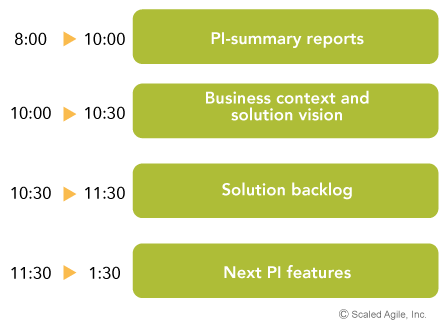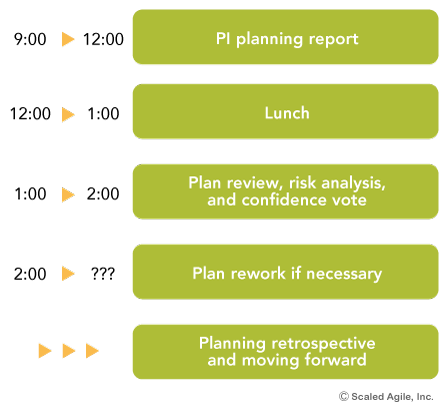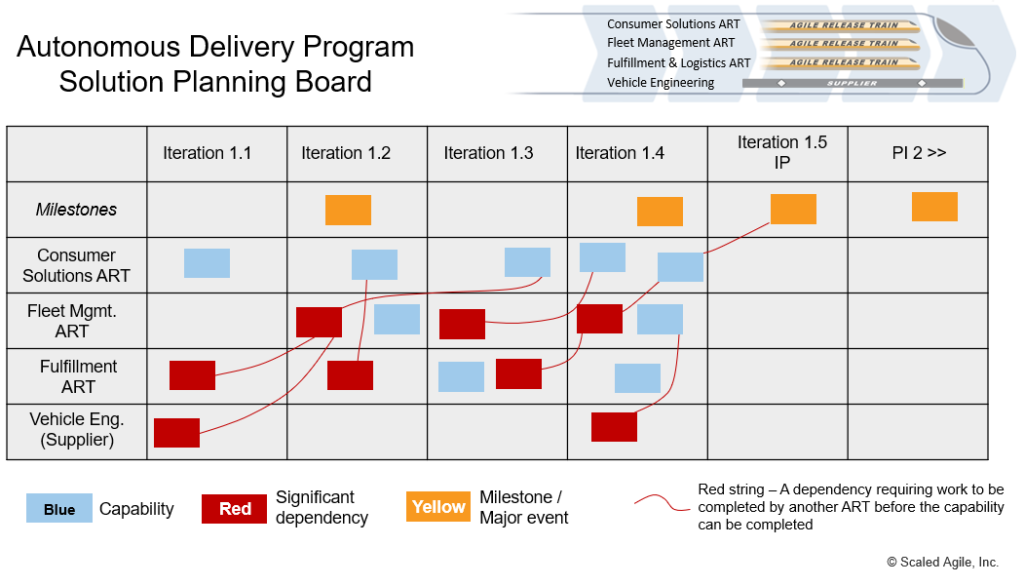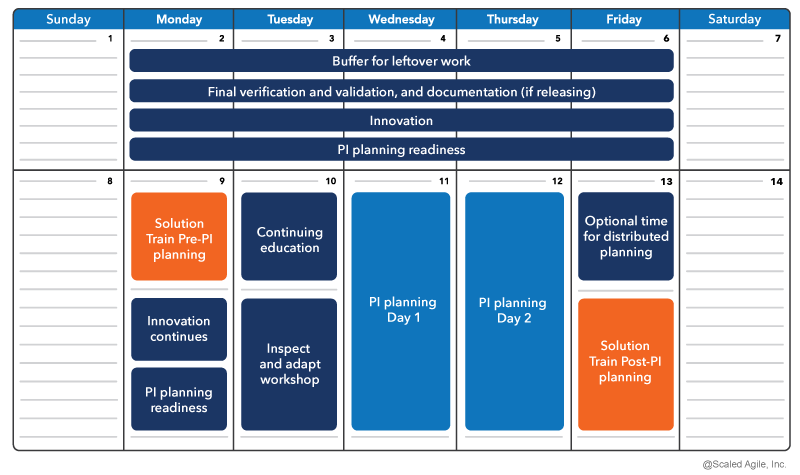Apply cadence, synchronize with cross-domain planning.
—SAFe Lean-Agile Principle #7
Pre- and Post-PI Planning
Pre– and Post–Program Increment (PI) Planning events are used to prepare for, and follow up after, PI Planning for Agile Release Trains (ARTs) and Suppliers in a Solution Train.Program Increment (PI) planning is the critical, cadence-based synchronization point for every ART. For Solution Trains, however, there are two additional activities: pre- and post-PI planning. They support and coordinate the various ARTs involved in the Solution Train. Planning at this higher level helps align Solution development as a whole and provides direction and visibility into where the trains are going to the next PI.
Details
Pre- and post-PI planning events allow Agile Release Trains and Suppliers in large Development Value Streams to build a unified plan for the next PI. The pre- and post-PI planning events serve as a wrapper for the PI planning at the Essential Level, where the actual detailed planning takes place and is incorporated into the Innovation and Planning (IP) Iteration calendar.
The pre-PI planning event is used to coordinate input objectives, Milestones, and business and solution context for the ART PI planning sessions.
The post-PI planning event is used to integrate the results of ART planning into the Vision and Roadmap for the larger value stream. At the end of the post-PI planning event, there should be an agreement on a set of solution-level PI Objectives to be implemented by the end of the PI and demoed at the next Solution Demo. As with PI planning, the pre- and post-PI planning events deliver several business benefits:
- Provide open and productive communication through face-to-face alignment
- Synchronize ARTs with Solution Train vision via the ART and solution PI objectives
- Identify dependencies and foster cross-ART coordination
- Provide the opportunity for just the right amount of solution-level architecture and user experience guidance (see the article, Lean UX)
- Match solution demand to ART capacities
Another benefit is team building across the Solution Train, which helps create the social fabric necessary to achieve high performance. Also, as planning is based on known velocities, the post-PI planning event is a critical step in continuously assessing and removing Work in Process (WIP).
Inputs and Outputs
Inputs to pre- and post-PI planning include the Solution Roadmap, vision, Solution Intent, and the top Capabilities from the Solution Backlog. Attendees include:
-
- Solution stakeholders, including Solution Train Engineer (STE), Solution Management, Solution Architect/Engineering, solution System Team, and Release Management
- Representatives from all the ARTs and suppliers, usually Release Train Engineers (RTEs), Product Management, System Architect/Engineering, Customers, and other primary stakeholders
Outputs include three primary artifacts:
- A set of aggregated specific, measurable, achievable, realistic, time-bound (SMART) PI objectives for the solution
- A solution planning board (shown below), which highlights the capabilities, anticipated delivery dates, and any other relevant milestones for the solution
- A confidence vote (commitment) to the solution PI objectives
This cadence based planning process guides delivery through the inevitable technical obstacles and twists and turns of the business and technology environment.
Gain Context in the Solution Demo
The solution demo is to the Solution Train, what the System Demo is to the ART. It is a regular opportunity to evaluate a fully integrated solution. Usually hosted by Solution Management, solution stakeholders typically attend. The insights from the demo will inform these stakeholders of the current objective assessment of solution progress, performance, and potential fitness for use. While the timing of the solution demo will vary based on the solution context, it provides critical objective inputs for the pre- and post-PI planning events.
Prepare for Pre- and Post-PI Planning
The pre- and post-PI planning events bring together stakeholders from all parts of the Solution Train. They require advance content preparation, coordination, and communication. The actual agendas and timelines listed below are a suggested way to run these events, but various value streams may adapt these to their capabilities and locations.
Regardless of how the timing and physical logistics are arranged, all the elements of these events must happen to achieve the right alignment across the trains and suppliers. It’s critical that there are clear vision and context that the right stakeholders participate, and that the primary activities take place, including:
- The executive briefing – Defines current business, solution, and customer context
- Solution vision briefing(s) – Briefings prepared by Solution Management, including the top capabilities in the solution backlog
- Define milestones – Clearly explain upcoming events and key dates
Set Planning Context in Pre-PI Planning
The pre-PI planning event is used to develop the context for the ARTs and suppliers to create their individual plans. A suggested agenda is shown in Figure 1 and each item is described next.

- PI summary reports – Each ART and supplier presents a brief report of the accomplishments of the previous PI. This doesn’t replace the solution demo, but it does provide the context of what has been achieved for the planning process.
- Business context and solution vision – A senior executive presents a briefing about the current state of the solution and portfolio. Solution Management presents the current solution vision and highlights changes from the previous PI. They may also present the roadmap for the next three PIs, as well as milestones that occur during that period to ensure that they are known and addressed.
- Solution backlog – Solution Management will review the top capabilities for the upcoming PI. Solution Architect/Engineering will discuss upcoming Enabler capabilities and Epics.
- Next PI features – Each ART’s Product Management will present the Program Backlog that they prepared for the next PI and discuss potential dependencies with other trains.
Solution Stakeholders Participate in ART PI Planning
The practical logistics of large solution planning may limit all solution stakeholders from participating. However, it’s critical that key stakeholders—particularly Solution Management, the Solution Train Engineer, and Solution Architect/Engineering—participate in as many of the ART PI planning sessions as possible. In many cases, ART planning sessions are concurrent, and these solution stakeholders may attend by circulating among the ART PI planning sessions. Suppliers and customers play a critical role as well, and they should be represented in ART PI planning.
Summarize Results in Post-PI Planning
The post-PI planning event occurs after the ARTs have run their respective planning sessions and are used to synchronize the ARTs and create the overall solution plan and roadmap. Participants include the solution and key ART stakeholders. A sample agenda is shown in Figure 2.

- PI planning report – Product Management from each ART presents their PI planning plans, explaining the PI objectives and when each is anticipated to be available. RTEs place their information on their ART’s row of the solution planning board and discuss dependencies with other ARTs or suppliers.
- Plan review, risk analysis, and confidence vote – All the participants review the complete solution-level plan. During PI planning, ARTs have identified critical risks and impediments that might affect meeting their objectives. Relevant risks are addressed in a broader solution context in front of the full group. One by one, risks are categorized and addressed in a clear, honest, and visible manner:
- Resolved – the issue is no longer a concern
- Owned – someone takes ownership since the problem cannot be immediately resolved
- Accepted – some risks are facts or issues that must be understood and accepted
- Mitigated – the impact of the risk can be reduced by implementing a contingency plan
Once all risks have been addressed, the Solution Train rates its confidence in meeting the solution’s PI objectives with a fist-of-five vote. If the average is three or more fingers, then management should accept the commitment. If the average is fewer than three fingers, then adjustments are made, and plans are reworked. Any person voting two fingers or fewer should be given time to voice their concerns, which might add to the list of risks.
- Plan rework as necessary – If necessary, the group revises its plans for as long as it takes for a commitment to be reached. This could cascade into follow-up events with the ARTs, as teams will need to be involved in any change to the plans.
- Planning retrospective and moving forward – Finally, the STE leads a brief retrospective of the pre- and post- PI planning sessions to capture what went well, what didn’t, and what could be done better next time. Then, subsequent steps are discussed, including capturing objectives, use of agile project management tooling, and finalizing the schedule of upcoming Solution Train activities and events.
Create the Right Outcomes
A successful event delivers three primary artifacts:
- A set of ‘SMART’ solution PI objectives for the Solution Train, with the business value set by Solution Management, Solution Architect/Engineering, and customers. This may include uncommitted objectives, which are goals built into the plan but not committed to by the solution. Uncommitted objectives provide the flexible capacity and scope management options needed to increase predictability and quality of PI execution.
- A solution planning board, which highlights the objectives, anticipated delivery dates, and any other relevant milestones, aggregated from the program boards, as Figure 3 illustrates.
- A commitment based on the confidence vote for meeting the solution PI objectives.

Next, the solution roadmap is updated based on the objectives for the planned PI. This is usually done by the STE and Solution Management after the post-PI planning session.
Coordinating Solution Train and ART Planning Events in the IP Iteration
Completing all the necessary refinement, pre- and post-planning, PI planning, and Inspect and Adapt (I&A) workshops for a Solution Train and its ARTs can represent a logistical challenge. STE and all RTEs sequence the events to ensure the correct stakeholders are present during planning. Figure 4 shows a sample schedule of a two-week IP iteration with all the solution and ART events sequenced for the ideal flow of inputs and outputs for each. Depending upon the scope and complexity of the solution, some organizations will find this pattern to be too simplistic and may require multiple pre-PI planning sessions to be done 4-6 weeks in advance. Remember, SAFe is a framework and use its principles as a guide to adapt your planning as needed.

For geographically distributed trains, scheduling I&A the day before PI planning is a common pattern, as many people might need to travel to a central location to participate. For cost-effective travel and venue scheduling, this usually requires an adjacent time block to conduct I&A and PI planning.
When logistics are not the overriding consideration, the alternative is to hold ART-level I&A workshops before the Solution Train I&A. This allows the output of the ART I&As—including demos, metrics, and problem-solving workshops—to flow into the Solution Train’s I&A process as inputs. The benefit is that solution stakeholders will have the most current picture of the state of the solution going into their planning events. Consider the design of the logistics as a hypothesis. Evaluate it and inspect and adapt as needed.
Last update: 10 February 2021


